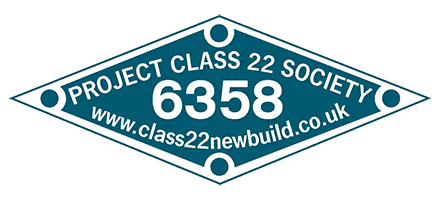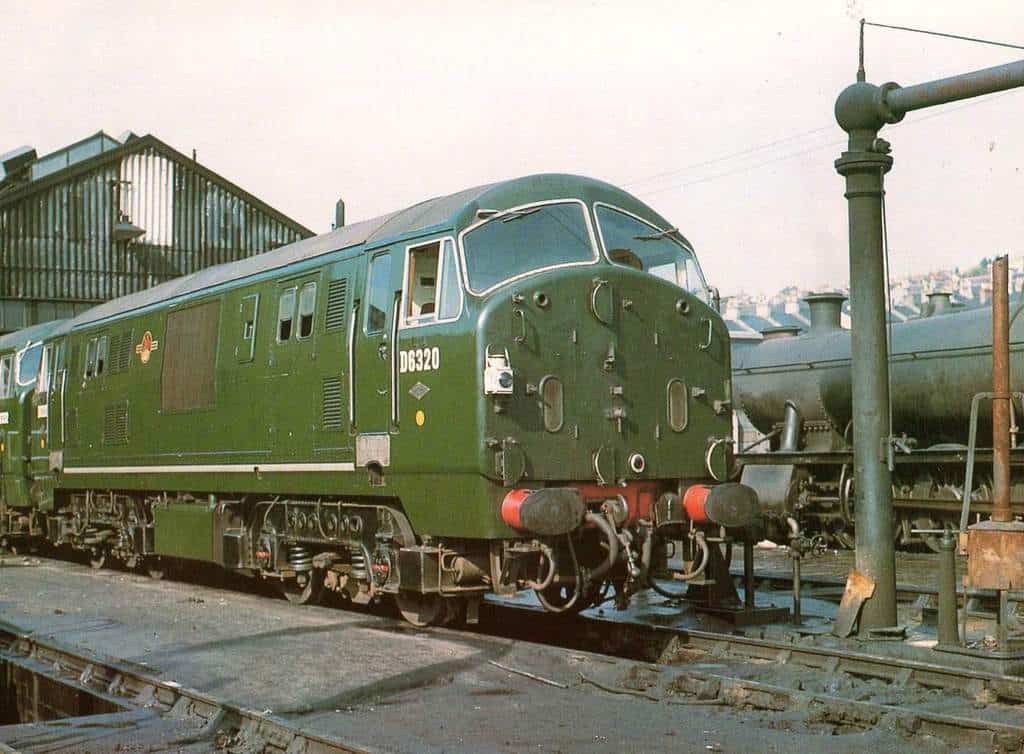
Frequently Asked Questions
Project 22 was devised by a group of volunteers formed though a Facebook Group, that intends to build a ‘fifty ninth’ British Railways Type 2 D63XX class locomotive using the original design and plans.
How long has Project 22 been going?
This project was established in March 2014.
Who runs Project 22?
A Committee runs Project 22, with tasks delegated to a Sub-Committee, and volunteering by Key Members (Link). The Committee usually meets at Derby or Reading.
Where are we based?
We don’t have a specific base, but we have a storage arrangement and use of workshop facilities at The Cab Yard in Bridgend in South Wales.
Is it really possible to build a locomotive?
Yes, it is possible; technically the skills still exist in the UK, and we are confident of finding all the essential components.
Where would you build it?
At this stage it is too early to say. There are options available us, and we are in outline discussions with three established engineering preservation organisations in the UK.
How long will it take to build?
We have estimated a project time of 10+ years from conception to completion, with assembly in the fourth quarter of the project. We will naturally be dependent on the level of support we receive along the way. We need more volunteers and lots of financial and other support.
How much will it cost?
First estimates indicate £1.2 million pounds.
How did you come to that figure?
Our estimates are based on figures published on the construction cost of recent steam locomotives projects.
Why build a Class 22?
Those who began the project liked the appearance of the NBL diesels and toyed with the idea of recreating one. The Class 22 offered the most straight-forward method of construction, as the company who built the originals used a fabricated shell attached to a frame, placed on a plate welded frame; a method very similar to building a steam locomotive. The bigger Class 41 option was rejected on a cost basis, with the difficulty in sourcing twice the number of key components.
Have you got any drawings?
Yes, and we are continually acquiring more. Obtaining them is a long and protracted task as there are in excess of 600 drawings available. We are only able to purchase them in batches of 20 at a time, and are at present ahead of our timetable for getting what we need within five years.
How do we prioritise the selection of plans?
We are collecting the drawings from two sources, neither of which have a full set, but between them we are sure will have sufficient to complete the build. We are acquiring plans in the same order as we will carry out the build – main frames first, followed by the bogie frames, wheel sets and cab (this last one to assist in our demonstration mock up). These account for the 120 or so drawings we already have; the remainder mainly deal with the rest of the superstructure and details such as piping, wiring, brackets etc. We also require the drawings for all the Swindon modifications that we will need to apply.
Do you have any components?
We have the engine and a number of cab controls as well as the buffers. There is a policy in place that planning takes president over parts, unless we are offered components that are specifically NBL. (Link).
We know you have an engine, what’s the plan for it?
We own one of the few remaining NBL MAN Engines, number 220. This engine was first used in a Class 22, and later a number of Class 42/43 Warships. We purchased 220 from the ELR Diesel Hydraulic Group, which had been in store for a number of years since use in the marine industry following sale from British Rail in 1970. Current plans for the engine will be a full overhaul as and when funds are available. It is currently stored safely at The Cab Yard. (Link).
Do you have a transmission and final drive?
At present, no. We understand that many of the Voith hydraulic transmissions were overhauled at Swindon Works and sold on for use in forestry and other industries. There is a possibility that some might still exist in a serviceable state. We have also been in communication with Voith in regard of an unserviceable transmission in store on the continent. As far as the final drives are concerned none were saved and therefore new ones will have to be re-manufactured, or converted from other uses.
Where will the loco be based when finished?
This will be dependent on the affiliations we create as we progress. We would like it to be based with another diesel hydraulic locomotive group, where we can utilise their experience and it can run with other original stablemates like Warships, Westerns and Hymeks. Many offers of interest have already been received, but there has been no firm decision made just yet.
Why go for a new build, rather than conversion of an existing locomotive?
Both options were carefully considered, but even from early days a new build seemed to have firm advantages, and would obviously be more authentic. The main frame was thought to have been formed of H-section girders at first, but more investigation has shown it to be of plate frame construction, permitting an easier new build than anticipated.
If converted, the closest donor locomotive would be the English Electric / British Railways Class 20, as this loco is only half an inch longer than that of the Class 22 length. If you stripped one down you would have a flat bed supporting equipment, that would require openings cut in it for the transmission, drive shafts and the engine. The positioning of the engine is the main reason for not using a Class 20 frame, because the Man/NBL L12v 18/21BS engine has almost a ‘drop sump’, that sits in between the main frames. By the time holes had been cut for this, the transmission, and drive shafts and it welded back together again the costs may work out to be about the same, but altering something to that extent means it will never be as strong as something new..
Where will you get components?
The engine and the transmission are the major components. We have the engine and are seeking a suitable Voith transmission. Many of the other components were in common use among locomotives built at the time and can be recovered from Class 47s as they come to the end of their working lives and are scrapped. If certain parts are no longer available, we expect they can be newly manufactured.
How will it be assembled?
Our current thinking is to place the contract for main frames and bogies with an engineering and welding company. The castings for the cabs, side sections including doors, louvers and wheels will also be contracted out, and then delivered to our site for assembly with the bogies and frames by engineers there.
We have costed a number of crane lifts and locomotive moves into our model, as it may be more cost-effective to take the loco elsewhere for wiring or painting, rather than bring contractors to our site, but this will be very much dependent on the location selected.
Will it go main line?
No. We have been advised by HMRI / ORR (Her Majesty’s Railway Inspectorate / the Office of Rail Regulation) of the build conditions we need to meet, and this can be reached without much difficulty for preservation usage but is much more difficult for main line where far more stringent build conditions must be met, much more paperwork is involved, and associated costs rise steeply.
It is possible our Class 22 may be dragged on the main line in a consist to and from Heritage Railways if certain key components meet compliance standards, which is our intention anyway. For instance, the loco originally would have only had a vacuum brake, and nowadays main line rail traffic requires air braking. Such a requirement could be overcome by either putting an air pipe through the locomotive internally which would then form up its brake pipe, or to mount an external air pipe which does the same thing. Fitting air brakes to D6358, although not original, would of course give more options of using the locomotive once built, but nothing has been finalised.
What colour would it be?
Initial opinion is corporate blue with yellow ends, fitted with head code boxes and numbered D6358, but thereafter it will be up to the membership and investors. It certainly will be original green at some point. Over time, the appearance of these locos changed greatly with modifications, livery variations and wear, which if we adopt some, should keep the differing appearance of the locomotive fresh for photographers and enthusiasts. Included among the original drawings for the 22 is a full batch of Swindon up-grade drawings which detail many of the improvements Swindon made to the design over the 10 years of service.
Will it be serviceable?
Yes. There had been talk at some time of building the loco without any internal equipment and taking it to galas, leaving it in a siding with ‘Do not move’ signs as a failed loco, simply for effect, but our eventual intention is for a reliable workhorse for heritage steam railways.
Weren’t such locos unreliable?
Reliability of the Class 22 locomotives was nowhere near as bad as some in the rail enthusiast press would have you believe, as by the mid 1960’s they were performing at 80% plus availability! There were a lot of enthusiasts when diesels were introduced who saw these locos as characterless things that were ousting their beloved steam, and there are quite a few with the same attitude today. Consequently, diesel failures were reported with glee whereas steam failures were generally ignored. Spares have been cited as a contributory problem with the manufacturer going bankrupt, but, this was not the case as Voith took over the company and continued to supply engine and transmission parts for as long as BR required.
Our maintenance plan is very different from that of British Railways as we will have a team of specialists dealing with the loco at all times with care.
Will it be built in The Cab Yard?
No, there are no facilities for such an operation there.
What is the cab yard?
The Cab Yard is the home of The South Wales Loco Cab Preservation Group, based in Bridgend, South Wales. Project 22 and the SWLCPG have a close working relationship and share a number of interests and facilities. We have safe secure dry storage for our components and engine. There is a small workshop facility where we can restore components recovered for the Project. (Link)
Can we help?
Yes, we can only complete this project if people come along and get involved.
Why do you need more volunteers?
Most of the work we are doing at the moment is based around research, planning, fundraising, publishing, and legal and compliance, information and sales stand plus networking. We are running a small business organisation that has to expand its scope far further than simply the engineering element of building a locomotive.
What do volunteers do?
Join the Project 22 team! We have tasks that involve a wide range of skills, from researching the history of Class 22s, contributing to “Lister” our electronic journal, and locating components. We need people with planning, CAD design, engineering, electrical engineering or fabrication welding expertise. Whatever you can do, we expect we can benefit from your involvement.
How much time would I have to commit?
As much as you can – an hour a week, to a day a week, … as long as we know, it doesn’t matter. There are working parties in South Wales for those interested in component restoration. We take our Merchandise and Sales Stand to Heritage Railway Galas across the UK, and could attend more with more volunteers. Offer us your time and your skill and we’ll try to plan you in somewhere.
Could I join the Committee?
If you are enthusiastic, competent, and can cover your costs, certainly! We have a Management Committee, sub-Committee, officers and advisers, which are only differentiated by the amount of input and expertise people are able to commit.
How often do you meet?
The committee are in daily contact using a specific Facebook group. We meet as required, but at least four meetings a year, plus Galas and working parties.
Why become a member?
The main reason is to support Project 22 and bring it to completion.
What types of membership are available?
We have a number of options:
Basic Member. Just register online, and you will receive ‘Lister’ and any P22 updates to your inbox.
Standard Membership. By paying £15.00 a year, you become a voting member and will be invited to the AGM. You will also receive discount on all merchandise access the ‘Members Only’ area on the website.
Investor Membership. Donate £10 or more per month, and you receive Standard Membership, access to the six-monthly reward draw, and shares when the loco is completed.
Why invest, what would that give me?
Making a monthly donation is the best way forward for Project 22 – we need to attract as many people as possible to this scheme. As an investor your donation is held in a build account and when the loco is completed all of your donation money will be transferred into transferable shares. As an investor you will be placed in periodic draws for a reward – in December 2015 this was a cab ride in a class 66 locomotive mainline for five hours with GBRf.
There also other privileges to be realised in the future when the loco is completed, including access and cab rides.
Where does the invested money go?
We hold a community business account with HSBC in Bridgend, South Wales.
90% of all invested money is held in a separate account and only used for the locomotive design and construction. If the project fails to continue, any funds left in this account can be returned equally or donated to another diesel hydraulic locomotive group in the UK.
Who is ‘The Phoenix Engineering Company Ltd’?
This is Project 22’s trading company, that is currently dormant.
What is the legal position of Project 22?
We are a mutual society governed by the rules of our constitution. ‘Project 22″ is our shortened name and the name of the original Facebook Group – sometimes further abbreviated to ‘P22’. Our official entity is: The Project Class 22 Society.
Do you have a formal business plan?
We have an interim business plan that outlines our aims and objectives and formalises our strategy for the build of this locomotive. It is made available to Standard Members, or upon request.
What other plans are in place?
We have a set of procedure manuals, a business plan, and action strategy document – this last item is a working instruction for the Committee to keep track of actions and tasks.
How do you keep up interest in the Project?
It is difficult while there is just a lot of preliminary essential background work being carried out in Project 22. We’ve now released our Journal “Lister” that is becoming “everything Class 22”, not just our projects and appeals, but a lot of pictures and historic dates and stories. We need to expand this to include other diesel hydraulic preservation groups and grow our free subscriber base, along with those who can contribute. A ‘Model Zone’ section is intended to be added, and there is also a good following on Facebook – our website will soon start sharing updates as well.
You will often see the ‘Project 22 on tour’ headboard on main line trains and preserved lines, as we attend a number of galas with the Merchandise and Information Stand.
How will you raise the money?
Phase 1: Memberships, Publications, Merchandise and Investors. This first phase has funded the engine, and minor components purchase, as well as covering the cost of the stand and administration equipment.
Phase 2: Attracting patrons to the Project. These are individuals with influence and experience in gaining and providing funding. We are also looking at income streams with advertising through interesting publications, both printed and electronic.
Phase 3: Grant funding, sponsorship, and increases in the business income streams.

